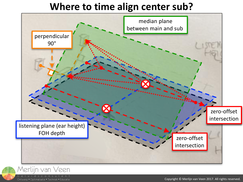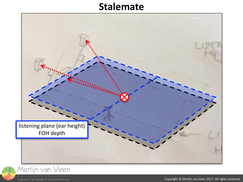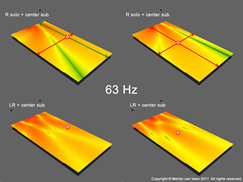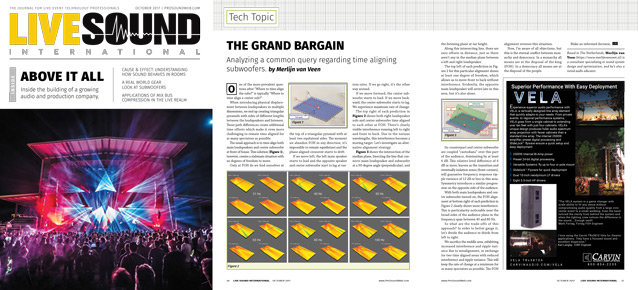 figure 1One of the more prevailing questions after "Where to time align the subs?" is typically "Where to time align a center sub?".
figure 1One of the more prevailing questions after "Where to time align the subs?" is typically "Where to time align a center sub?".
When we introduce physical displacement between loudspeakers in multiple dimensions, we end up creating triangular pyramids with sides of different lengths between the loudspeakers and listeners.
These path differences create additional time offsets which make it even more challenging to remain time aligned for as many spectators as possible.
 figure 2The typical approach is to time align both main speakers and center subwoofer at FOH. This solution (figure 2) however, creates a stalemate situation with no degrees of freedom to move.
figure 2The typical approach is to time align both main speakers and center subwoofer at FOH. This solution (figure 2) however, creates a stalemate situation with no degrees of freedom to move.
Only at FOH do we find ourselves at the top of a triangular pyramid with at least two equilateral sides. The moment we abandon FOH in any direction, it's impossible to remain equidistant and the phase aligned crossover starts to drift.
If we move left, the left main speaker starts to lead and the opposite speaker and center subwoofer start to lag at various rates. If we go right, it's the other way around.
If we move forward, the center subwoofer starts to lead. If we move backward, the center subwoofer starts to lag. We experience maximum rate of change. animation 1The top right prediction in animation 1 shows both right speaker solo and center subwoofer, time aligned to each other at FOH.
animation 1The top right prediction in animation 1 shows both right speaker solo and center subwoofer, time aligned to each other at FOH.
There's clearly visible interference running left to right and front to back. Due to the various wavelengths, this interference becomes a moving target. Let's investigate an alternative alignment strategy.
Figure 1 at the beginning of this article, shows the intersection of the median plane, bisecting the line that connects main speaker and subwoofer at a 90° angle (perpendicular), and the listening plane at ear height.
Along this intersecting line, there are zero offsets in distance. Just like there aren't any in the median plane between a left and and a right speaker.
The top left prediction in animation 1 for this particular alignment, shows at least one degree of freedom which allows us to move front to back without interference. Evidently, the opposite main speaker will arrive late in this area, but it's also alone.
Its counterpart and center subwoofer are coupled custodians over this part of the audience, dominating by at least 6 dB. This relative level difference of 6 dB or more, known as the transition and eventually isolation zones (front corners), will guarantee frequency response ripple variance of 12 dB or less in this area. Symmetry introduces a similar progression on the opposite side of the audience.
With both main speakers and center subwoofer turned on, the FOH alignment in animation 1 (bottom right) clearly shows more interference. This is particularity noticeable near the broad sides of the audience plane in the frequency span between 40 and 80 Hz.
So what are the trade-offs of this approach? In order to better gauge this, let's divide the audience in thirds from left to right.
We sacrifice the middle area, exhibiting increased interference and ripple variance due to misalignment, in exchange for two time aligned areas with reduced interference and ripple variance.
This will keep the rate of change at a minimum for as many spectators as possible. The FOH alignment reverses this situation.
Now I'm aware of all objections, but this is the eternal conflict between monarchy and democracy.
In a monarchy all means are at the disposal of the king (FOH). In a democracy all means are at the disposal of the people.
Make an informed decision.
 This article is also featured in the October 2017 edition of Live Sound International magazine.
This article is also featured in the October 2017 edition of Live Sound International magazine.
